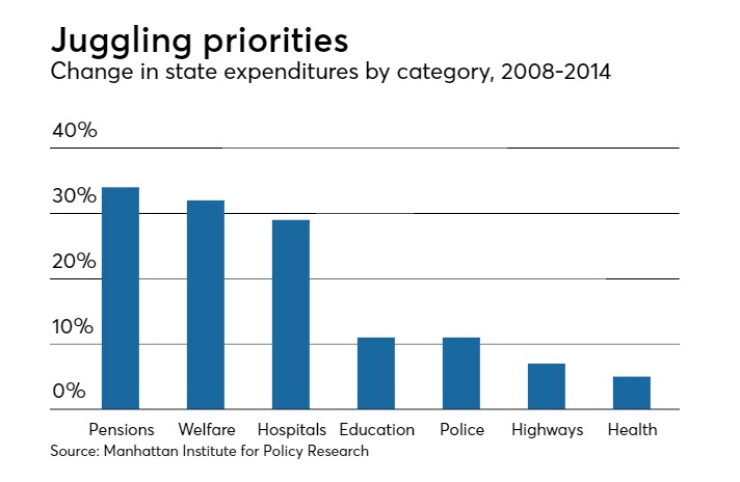Growth in public pension spending is largely driving financial stress among public colleges and universities nationwide, according to a
Between 2008 and 2015, state pension expenditures and liabilities have risen by an average of 61%, the free-market leaning think tank said in its report, released Thursday, while per-student higher-education spending has fallen by 22.4%.

The authors, Manhattan Institute senior fellow Daniel DiSalvo and City University of New York assistant professor Jeffrey Kucik, called the two developments “inextricably linked.”
State funding for higher education, adjusted for inflation, is nearly $10 billion below 2008 levels.
DiSalvo and Kucik said higher-education spending is a relatively easy target for cuts, whereas powerful interest groups protect public pensions.
They argued that states are failing to strike the appropriate balance between past and future.
“In the wake of the Great Recession, all 50 states enacted pension reforms of some kind. Unfortunately, these reforms didn’t go nearly far enough, and pension debt has continued to rise steadily since 2008,” they said.
“Forced to adhere to balanced-budget requirements, many state governments have been confronted with tough fiscal choices. One choice that nearly every state has made is to cut funding for higher education.”
Spending on pensions has increased more, as a percentage, than any other area, said the authors.
“By contrast, higher education is the only category in which spending has contracted. States are paying less for higher education so that they can avoid tax increases or other spending cuts.”
Some states, such as Minnesota and Pennsylvania, more than doubled their pension expenditures, while others increased theirs significantly less. The average per-state increase in pension expenditures was 47%, said DiSalvo and Kucik.
The biggest losers, they said, are students from low-income backgrounds.
“Historically, public colleges and universities have been the primary avenue of upward mobility for poor and lower-middle-class students.”
They cited data from the Equality of Opportunity Project show that showed the CUNY system propelled almost six times as many low-income students into the middle class and beyond as all eight Ivy League campuses, plus Duke, Massachusetts Institute of Technology, Stanford and University of Chicago combined.
“Yet systems like CUNY are struggling as a result of cuts in Albany,” they added.





